GUIDE TO NEW RIGS AND
RIG FLOOR EQUIPMENT 2010
Rig Floor Equipment
Trackless iron roughneck, pipe transfer tool improve safety
National Oilwell Varco’s latest iron roughneck model, the ST-120, was designed to bring high-specification roughneck features to a retrofit market. The torque wrench design has a full 60° of rotation and three-point bite for better grip, quicker makeup and less box deformation on the connection. The tool applies reliable makeup torque, resulting in higher-quality connection makeup and less opportunity for downhole failure. Combined with a high-torque spinning wrench design, the new iron roughneck is fully equipped to handle high-performance drill pipe connections.
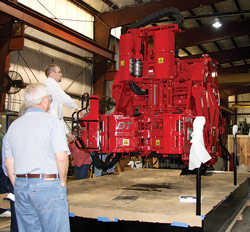
|
NOV’s latest iron roughneck model is completely retractable and measures just over 60 in. from the pedestal pivot, minimizing its footprint and providing more room on the rig floor. Its trackless design eliminates trip hazards on the floor.
|
|
The tool is completely retractable and measures just over 60 in. from the pedestal pivot, minimizing its footprint and providing more room on the rig floor. When fully extended, the tool travels a full 12 ft, allowing versatile layout configurations. The trackless design means no trip hazard on the floor, which increases crew safety.
Manual control is carried forward from the new iron roughneck, with options for either remote manual controls from a floor-mounted local control station or fully automated controls from either the driller’s control console or a handheld wireless remote control. Manual controls can be mounted on either side of the unit. The wireless remote control option allows for “hands off” operation while still permitting manual backup in the event of an emergency.
Another new rig floor tool, the patent-pending Stand Transfer Vehicle (STV-10) provides what NOV describes as a step change to move the derrickman out of the derrick to a safe area in a driller’s cabin. Designed for use in most double- and triple-mast applications, the tool integrates into existing fingerboard footprints and only marginally increases the weight of the fingerboard. It utilizes a compact scissor-arm system that fits between the setbacks but also reaches well center and all slots in the fingerboard with its 8 ft of travel (10 ft of overall reach).
The pipe transfer tool can quickly retain and release the stand during handover to the hydraulic elevator or to the fingerboard slots, using a patented stand capture head and a secondary pipe retention system on the fingerboard. Primary electric-over-hydraulic controls with dual high-resolution camera feedback provide safe, fast and reliable tripping of 3½-in. to 10-in. stands of tubing, drill pipe and drill collars.
The vehicle easily installs into the mast by means of an integral fingerboard with diving board in a modular two-piece design. Also included are a remote control station, a local control station and a maintenance platform.
Makeup and breakout equipment handles wide tubular range
Weatherford’s new UniSlips rotary-mounted, multifunctional slip can be used to handle casing, tubing or drill pipe. The versatile slip incorporates a proprietary dual-wedge slip design that can handle any tubular within a size range of 2⅜-in. to 16-in. OD without changing slips, which can save time when making up bottomhole assemblies or running tapered flanges.
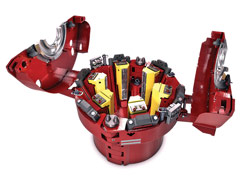
|
The UniSlips rotary-mounted slip incorporates a proprietary dual-wedge design that can handle any tubular within a size range of 2⅜-in. to 16-in. OD without changing slips.
|
|
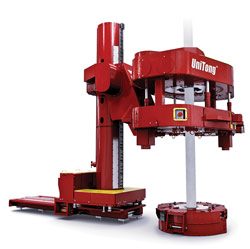
|
The UniTong makeup/breakout tool consolidates the roles of casing and tubing tongs, an iron roughneck, a mud bucket and cleaning and doping devices into one system.
|
|
The slip incorporates a power-grip feature that counteracts up to 80,000 ft-lb of torque, which eliminates the need for manual backup tongs, increasing crew safety. It fits into a 37½-in. rotary table and is rated for 500 short tons.
The handling tool includes two opposing slots for safe handling of control lines or umbilicals when running completion strings or production and workover risers. A 19-in. slip opening accommodates large-OD string components. Minimal marking slip inserts are available for running special alloy tubulars.
The slip can be used with the company’s UniTong system, which is designed to make up and break out tubulars including drill pipe, casing and tubing in diameters ranging from 2⅜ in. to 20 in. The system, with a torque capacity of 150,000 ft-lb, consolidates the roles of casing and tubing tongs, an iron roughneck, a mud bucket and cleaning and doping devices into one system. According to company literature, one tong system can replace the iron roughneck, casing tongs, tubing tongs, dope applicator, wash applicator, spinner units, mud bucket, manipulator arm, safety clamp, stabbing guides and torque/turn computer. The company also says the tongs can eliminate trips to and from the well center, minimize personnel requirements, decrease operator training time, reduce equipment expenditures, save rig floor space, increase safety by removing personnel from high-risk zones and minimize the use of manual rig tongs.
The tool is designed to remain concentric to the drillstring during operations. However, the frame permits the system to move above the pipe in the rotary and travel away from the well center if needed. The tong eliminates the need for independent casing and tubing tongs.
A rotating component in the tong contains the gripping elements, with the rotation enabling the grippers to build up the necessary torque to make up or break out tubular connections. A unique design feature is cylinders that enable operators to elevate the makeup tong and that also compensate for the weight of the tubular stand being made up or broken out.
The tong can be arranged in a double-column configuration or a single-column configuration to save space on the rig floor and to permit the system to move backward and forward as well as rotate. The single-column configuration can be placed up to 9.8 ft from the rotary center.
Marine engine series expands into offshore oil and gas
Caterpillar Global Petroleum is making available its MaK product line for applications in the offshore oil and gas industry. The line of engines has long been available for the marine industry, and comprises four engine families with power output ranging from 1,020 kW at 900 rpm to 16,000 kW at 514 rpm.
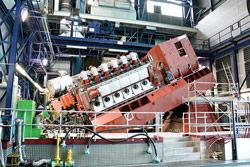
|
The MaK 12-cylinder M 32 C engine, shown here on a test bed, is designed for use in the dynamic positioning systems of floating rigs.
|
|
The 12- and 16-cylinder M 32 C engine ratings of 5,760 kW and 7,680 kW at 720 rpm are designed for use in large dynamically positioned semisubmersibles and drillships. The largest engine, the
M 43 C, with 12 or 16 cylinders, doubles the output of the M 32 C engines to 16 MW, sufficient to serve the needs of large FPSO vessels, multipurpose crane, pipelay and drill-assist vessels (MPVs) and other production units.
The M 32 C and M 43 C engines are offered as complete power systems. They comply with International Marine Organization Tier II (IMO II) emission requirements and fulfill Marpol 73/78 Annex VI air pollution standards. Additional options are available to support environmentally sensitive areas with smokeless operations. The engines feature large inspection openings for access to core engine internals for easier serviceability, with core engine components designed for reconditioning and reuse at overhaul.
Standard modular design of the generator set allows for ease of installation and reduced complexity, including pumps and filters installed on the engine. The cooling water system is attached with simple plug-in connections. A full range of factory-installed engine attachments provides customization and a reduction in installation time.
Offshore drilling power module designed for easy installation
Cummins Inc.’s line of power modules includes the QSK60 offshore drilling power module as well as several land-based drilling power modules including the QSK50 (50 Hz) and KTA50 (60 Hz).
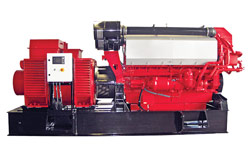
|
The QSK60 is specifically designed, built and tested for offshore oil and gas drilling applications.
|
|
The Tier 2 QSK60 offshore drilling power module is rated for 1,855 hp (1,383 kW) at 1,200 rpm with a 10% overload capability, and is integrated with a Cummins-manufactured AvK DSG99 alternator at 2,150 kVA and 690 V. The power module is designed for the durability, reliability and power density requirements of high-hour and hard-duty offshore drilling applications.
The Cummins Modular Common Rail (MCR) fuel system enables full-authority electronic control over fuel timing, quantity, pressure and delivery rate shape. Precision control over the number of injection events enables optimal performance, fuel economy, smooth power delivery, better idle stability and dramatically reduced engine noise, as well as providing the capability for an in-cylinder Tier 2 emissions solution.
The MCR fuel system is optimized for load requirements in drilling applications, allowing the power module to achieve a 4–9% fuel economy advantage over competitive Tier 1 and Tier 2 products of similar speeds and ratings, according to the company. The fuel system also gives the power module a fine-tuned fuel calibration to meet all marine regulations, including EPA Marine Tier 2, IMO Tier 1 and EC Directive Regulations.
The power module is designed to provide the lowest installation cost for repowering by using customer interfaces similar to competitor packages for quick installation in rigs that allow for the easiest accessibility. It is also designed with common mounting arrangements.
An electronic information system with a C-Command Elite and Elite Plus panel protects and enhances engine performance and manages cost. The information system provides controls capable of withstanding marine environments. The controls use presentations of engine parameters,
multilingual touch screens with full-color text and graphics, and remote panel options to simultaneously monitor up to eight engines. For customers interested in using their own controls, the engine can accept speed signals in 0–10 VDC, 0–200 mA, or Modbus protocols as well.
The Advanced Engine Monitoring (AEM) system provides a high level of visibility into the engine’s performance with extended data logging capturing information on fuel consumption, duty cycle and load factor, operational trends, fault snapshots and shutdown information.
The Eliminator oil filtration system on the power module reduces lube system maintenance costs up to 90% while increasing uptime by allowing up to 1,000 hours between filter changes, according to the company. The optional Centinel lube system can extend this interval to 4,000 hours for greater uptime.
Mechanically activated casing running tool
Canadian manufacturer Volant Oil Tools introduced a suite of mechanically activated, internal-grip casing running tools capable of casing makeup, casing running, string rotation, circulation, and drilling or reaming with casing. The CRTi uses a patent-pending fully mechanical torque-activated wedge grip architecture.
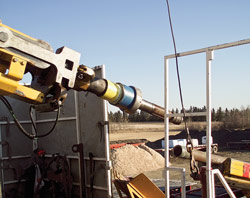
|
Volant Oil Tools’ CRTi casing running tool operates as an extension of the top drive.
|
|
Once the tool has been set, application of torque in either rotational direction, hoisting load or combinations thereof tends to increase the mechanical gripping force applied to the internal surface of the casing. A range of casing weights can be handled with a single set of dies, and after simple reconfiguration, the same base tool can run multiple casing sizes.
The tool is controlled solely through mechanical actions imposed by the rig’s top drive unit, which the company says provides intuitive and inherently safe operation. Also, with no hydraulic lines or fittings to connect, rigging in or out takes a few minutes, compared with hours for some other systems. An independently operated hydraulic control unit prevents potential miscommunication.
The compact design lets drillers run Range 3 casing on most hybrid and pipe-arm-assisted automated rigs. With its light weight and short overall length, the tool can be transported via pickup truck.
Rigging in on automated rigs equipped with pipe arms is simple and fast. First, the tool is inserted and manually set into casing on the racks. The joint is then picked up with the rig’s pipe handling system, presenting the casing and casing running tool to the top drive quill, which is then threaded into the tool joint. The top drive then lowers the casing to the slips to apply final torque to the tool joint.
On double and triple rigs, the tool is placed in the first joint of casing, which is then brought to the rig floor using the bales and elevators. Once this casing joint has been set in the slips, the top drive quill can be threaded into the tool joint at the top end of the tool, which is then ready to run casing.
When rigging out, the top drive releases the tool from the casing, standard rig equipment breaks the drill collar connection, and the tugger line pulls the tool clear of the casing.
The company offers five different models to cover casing sizes from 4½ in. through 30 in., with hoisting capacities ranging from 120 to 660 tons and torques of 13,000–85,000 ft-lb. The fully mechanical design enables higher push and pull-down capacities than hydraulically operated tools. All tools are designed and tested to comply with API 8C specifications, and can be supplied product-certified by Det Norske Veritas.
Pipe handler with ‘fly by wire’ control heading to North Sea
TSC Offshore recently supplied a pipe handling system for Statoil’s Statfjord late-life project at the Statfjord C drilling platform in Block 33/9 of the Norwegian North Sea, and is commissioning the system for use. The system consists of a pipe handling crane, conveyor and conveyor substructure designed to move drill pipe, drill collars and casing from storage racks on the pipe deck to the drill floor in a series of coordinated operations.
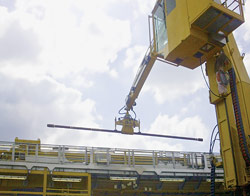
|
TSC Offshore’s pipe handling system is being commissioned for use on Statoil’s Statfjord C platform as part of a late-life project to extend the life of the mature field.
|
|
The pipe handling crane is fitted with a grab and has four degrees of freedom: slew, luff, extend and grab-rotate. It has load capacities of 3.5 tons at 40-ft extension and 1.9 tons at 70-ft extension. The crane folds into a compact form, allowing it to move under the substructure to the other side of the platform as needed.
The control system provides “fly by wire” operation using joysticks and push-button controls. A human-machine interface (HMI) provides further operator control with an anti-collision system and alarms. A closed-circuit television camera on the grab assists in positioning.
Single tubulars lifted by the crane are then transferred to the conveyor feed table. From there, they are automatically transferred to the conveyor belt. This, in turn, moves the tubulars to a tailing arm and then to well center. PLC control and under-belt sensors allow automated operation for long tubulars. The substructure supports the conveyor, provides access between the drill floor and the pipe deck, and serves as an emergency escape route. It is lifted during derrick skidding.
A second, similar pipe handling system is being fabricated for Statoil’s Statfjord B platform for delivery by the end of the first quarter of 2011. The Statfjord late-life project is improving recovery and extending the life of the mature Statfjord oil field through an extensive well program as well as modifications to the platforms.
|









